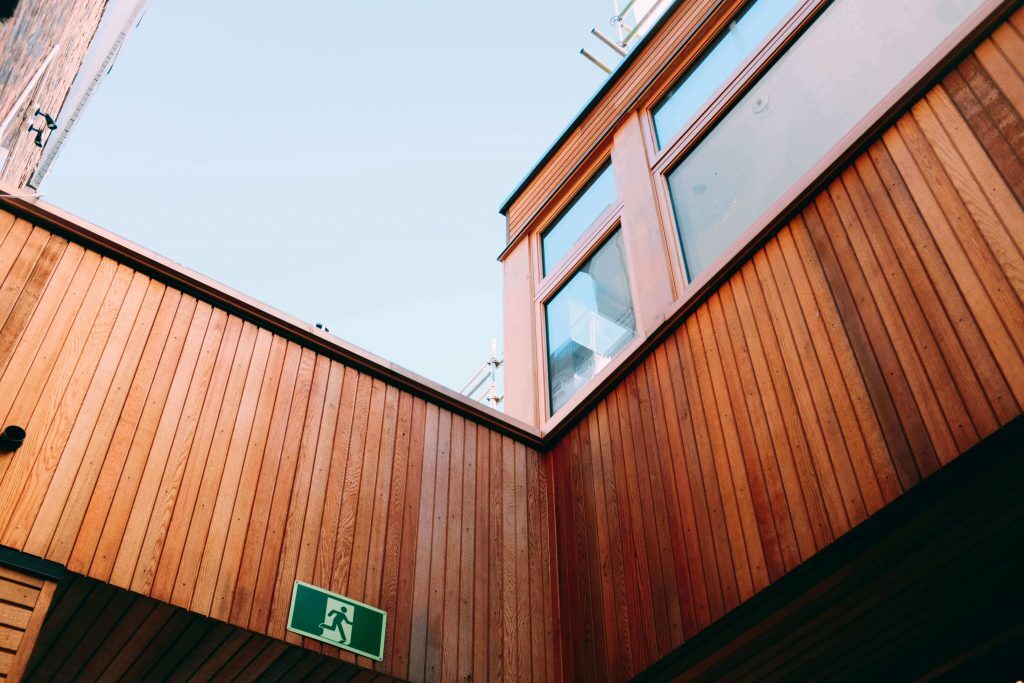A Homeowner’s Guide to Home Exteriors
Published on Wednesday June 5, 2019
One of the first things that people notice about your home is its exterior, whether it’s vinyl, brick, stucco or wood. But with a variety of options available, it can be challenging to decide which style best fits your home.
The type of siding you choose not only affects curb appeal, but it can also have a serious impact on your home structure and long-term home maintenance budget.
To help you narrow down your options, we compiled a list of some of the most popular home exteriors to help you get your siding replacement project going.
Popular home exteriors
Wood siding

Wood siding has been used on homes for centuries and has never fallen out of style. As such, it’s a popular choice for both historic and modern homes. Wood is one of the most classic of the home exteriors that we’re discussing, but it’s also one of the most demanding, high-maintenance and expensive options.
Wood can be cut into a wide variety of widths, stained or painted a variety of colors and come in a variety of profiles (bevel, tongue-and-groove, shingle, etc.). This customizability, combined with the fact that it’s a naturally occurring material, is what often increases its price.
Another reason why wood can be expensive is the high cost associated with post-installation maintenance. Wood fades over time due to weather and climate, and while the quality of the siding is not affected by this, you’re losing out on that classic look and feel you originally paid for.
Wood siding can also warp, rot or fall off in sections as it ages. To keep it in top shape, it will need occasional cleaning, caulking, patching and upkeep — and that often comes with a high price tag.
Brick veneer

A brick house is about as classic as they come. In this day and age, though, most “brick houses” aren’t actually brick at all — they’re brick veneer. Cheaper and easier to install than the real thing, brick veneer has grown in popularity over the past few decades since it adds value to your home without the high cost of actual brick.
Even though it’s artificial, brick veneer still has a lot of the same benefits of its natural counterpart: it’s fireproof, a great insulator, energy efficient and extremely durable. It also keeps the general thickness of real brick, which makes it great at soundproofing your home from outside noise.
While brick veneer is cheaper than actual brick, it’s still more expensive and takes longer to install than other siding options like vinyl or aluminum. Oftentimes a foundation assessment will be needed to determine if brick or brick veneer is the proper, structural choice for your house. Tally this up with the cost of labor in addition to the materials themselves and you’re looking at a pretty hefty price tag.
Stucco

Stucco, a mixture of Portland cement, sand, lime and water, has a lot going for it from a technical perspective. It’s a great insulator, solid and durable, cheap to maintain, easy to color customize and usually has a warranty life of 15 years. Stucco is a popular choice for homes in areas of extreme heat (like the American Southwest) because of its ability to keep hot summer air out.
However, due to its multilayer construction, it’s not the cheapest to install. Unlike many other siding options like wood or vinyl, stucco is applied layer after layer, with each layer needing to dry completely before another can be added. So even though the materials needed for stucco are fairly cheap, the labor costs it requires makes it a fairly pricey home exterior option.
In addition to the price, stucco is not the most eye-catching home exterior option, nor is it fit for every climate. Since stucco is porous, consistent rain can seep into it and cause it to break. Once stucco has chipped, it can be difficult to repair and patch, so keeping stucco in good condition is vitally important to your investment.
Vinyl siding

Walk down almost any street and you’ll find a house with vinyl siding. Vinyl siding is one of the most popular types of home exteriors in the country because it reduces noise pollution, increases the value of your home and may even cut down your energy bills.
One of the top benefits of vinyl siding is its classic look and customizability. Since it’s a manufactured product, it comes in a wide variety of colors and hues, allowing you to pick exactly the right color to fit your home. In addition to the classic horizontal style, vinyl siding can also be crafted to mimic the popular wooden shake style.
LONG siding is specially engineered to hide scratches, protect against fading and eliminate the effects of UV light. Even though it’s only .046” thick, it’s still able to provide 300% more impact resistance than typical siding, so you never have to worry about the integrity of your siding. Resistant against peeling, cracking, expansion and contraction, and dents, LONG siding is built to last.
Put your home’s best face forward
No matter your budget or style, LONG has the perfect siding option for your home. From shake-style shingles to the traditional horizontal tongue-and-groove, we’ll walk you through it all to get your home looking it’s very best. Contact us online to request a quote and schedule an in-home consultation today.
Interested in Long Home Products?
See our special offers now.








